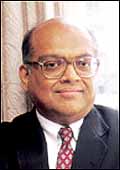 |
| S. Rajam, CEO, Ittiam Systems:
Going global with DMA |
It seems somehow apt that a company
that takes its name from Rene Descartes' famous Cogito Ergo Sum
quote decides to come up with a product to showcase its chip-design
skills-sort of like a 'We've produced this innovative product, therefore
we must be good', statement. That's exactly what Bangalore-based
Ittiam Systems (I Think, Therefore I AM, see?) has done. The company
is a global wannabe in the Digital Signal Processor-design space;
so, what better way of establishing itself than coming out with
a prototype combo player, the Digital Media Album (DMA for short)?
"DMA," says Srini Rajam, Ittiam's CEO and a chip-industry
vet (he headed Texas Instruments' Indian ops for nearly a decade),
"is a multimedia Swiss Army Knife". "It can store
and play pictures, music, and movies, act as a digital video recorder,
a digital camera, and a camcorder". The company developed the
hardware and the software that goes into DMA locally. When Ittiam
started out, it decided that it would make money from licensing
Intellectual Property (IP). "But corporate customers want to
see the end result," explains Rajam. Ergo, "this mother
of all media appliances that showcases our software IP". For
the record, eight IPS have gone into DMA, and the company claims
the applications for the technologies used in the product are "mind
boggling".
Already, several global consumer majors that have seen the prototype,
are excited, but Ittiam, in keeping with its original philosophy
doesn't plan on entering the realm of mass production. Instead,
it'll be content to sell the IP.
-Venkatesha Babu
UNIFIED LICENSING
Trouble Ahead
Why
the unified licence will not end litigation in telecom.
- There's nothing for the cellular companies in the unified licence
regime, and given that they benefited from the government's decision
to move from a licence-fee structure to a revenue-sharing one
in 1999, it is unlikely that the future holds anything.
- There's a feeling that the Rs 485 crore penalty levied on Reliance
Infocomm for providing `full mobile' services is too low, given
that the company has acquired some five million customers on the
strength of it.
- In the case of some circles and some operators (Tata Tele in
Andhra Pradesh and HFCL in Punjab), the licence fee paid by basic
telephony companies is higher than that paid by companies that
acquired the fourth cellular telephony licence. Given that this
is the basis for determining entry fee into mobile telephony for
basic telephony companies, are Tata Tele and HFCL eligible for
a refund?
- What happens when an operator in a certain circle decides not
to migrate to an unified licence?
- Bharti, and this is a unique case, wants to return its basic
telephony licences because it has cellular telephony ones in the
same circles and can, according to the terms of the unified licence,
provide both services on the strength of these. Oops!
- Given that India's telecom regulator is working on a real unified
licence (basic plus cellular plus domestic and international long
distance plus whatever else it can think of), what happens then?
-Vandana Gombar
DASH
BOARD
 A+ A+
To Ashwin Dani for proving that vengeance is a dish best eaten cold.
Six years after ICI Plc's abortive attempt to acquire a 9.1 per
cent stake in Asian Paints, the company has acquired the government's
9.2 per cent stake in ICI India. Bravo!
X
To BSE Sensex. It crossed the 5000 mark on November 3, something
no one could have predicted at the beginning this then dismal year.
We'd like to think it is poised to go even higher, but given the
unpredictability of Indian bourses we'll take refuge in that universal
symbol of the unknown (X).
"Talent
Here Is Incredible"
From
your car to your rocking chair to your toothbrush, almost everything
that you use today is designed. And increasingly, manufacturers
are turning to computers to do the designing. The $120-million SolidWorks,
a subsidiary of Dassault Systems, is the biggest vendor of three
dimensional (3D) computer-aided design (CAD). Its CEO, John
McEleney, was in India recently and spoke to BT's Venkatesha
Babu on the technology and the Indian market. Excerpts:
Why has design become such a critical issue?
Markets have become very competitive. A 3D model is worth a thousand
2d drawings. But improved visualisation is only the tip of the iceberg
of productivity gains. CAD gets products on store shelves faster.
It allows designers to make mistakes and rectify them inexpensively,
since (3D) solid models can be pushed, pulled, turned on the computer
screen.
How do you see the Indian market?
Because of the low cost of engineering skills, India has been a
traditional 2d market. But as India tries to become competitive
in manufacturing on a global basis and costs of cutting-edge engineering
skills rise, a lot of 2D users will migrate to 3D.
SolidWorks has been late to India's $25 million CAD/CAM market...
Yes, but we've had presence through distributors who have sold
more than 900 licences to 400 customers, including EID Parry, ABB
and Ucal. We are looking to enhancing our 5 per cent market share
in India to reflect our global leadership in the space. Last year,
we set up our development centre in Pune and I am happy at the progress
done here. With nearly 44 employees, it designs nearly 10 per cent
of our software. The amount of talent here is incredible. We want
to tap the Indian market both for the selling opportunity as well
as a resource base.
|
